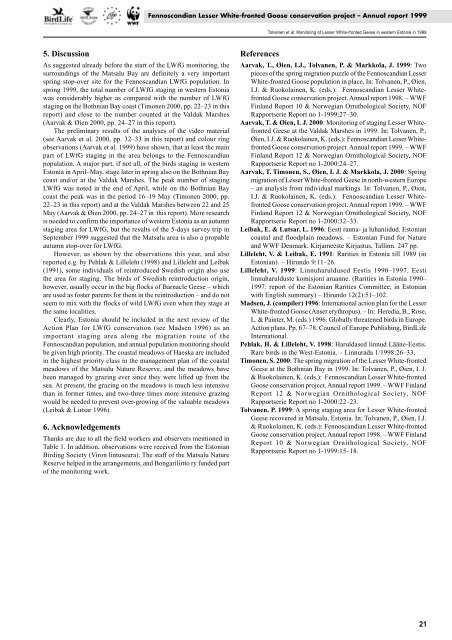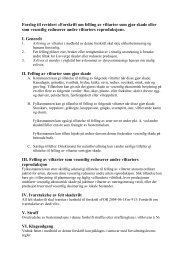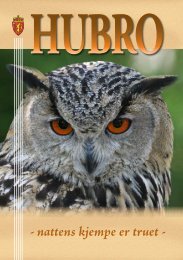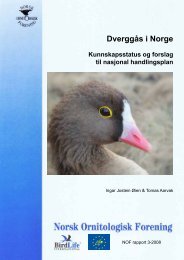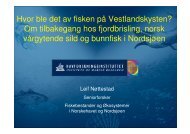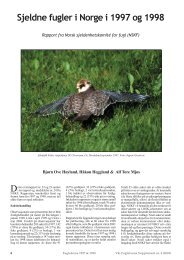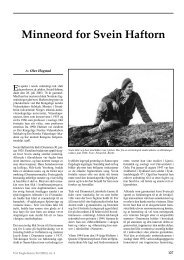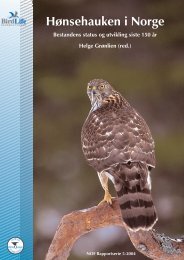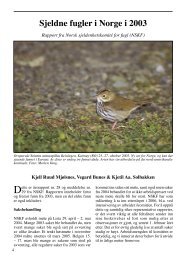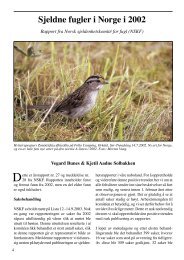Fennoscandian Lesser White-fronted Goose conservation project ...
Fennoscandian Lesser White-fronted Goose conservation project ...
Fennoscandian Lesser White-fronted Goose conservation project ...
Create successful ePaper yourself
Turn your PDF publications into a flip-book with our unique Google optimized e-Paper software.
5. Discussion<br />
As suggested already before the start of the LWfG monitoring, the<br />
surroundings of the Matsalu Bay are definitely a very important<br />
spring stop-over site for the <strong>Fennoscandian</strong> LWfG population. In<br />
spring 1999, the total number of LWfG staging in western Estonia<br />
was considerably higher as compared with the number of LWfG<br />
staging on the Bothnian Bay coast (Timonen 2000, pp. 22–23 in this<br />
report) and close to the number counted at the Valdak Marshes<br />
(Aarvak & Øien 2000, pp. 24–27 in this report).<br />
The preliminary results of the analyses of the video material<br />
(see Aarvak et al. 2000, pp. 32–33 in this report) and colour ring<br />
observations (Aarvak et al. 1999) have shown, that at least the main<br />
part of LWfG staging in the area belongs to the <strong>Fennoscandian</strong><br />
population. A major part, if not all, of the birds staging in western<br />
Estonia in April–May, stage later in spring also on the Bothnian Bay<br />
coast and/or at the Valdak Marshes. The peak number of staging<br />
LWfG was noted in the end of April, while on the Bothnian Bay<br />
coast the peak was in the period 16–19 May (Timonen 2000, pp.<br />
22–23 in this report) and at the Valdak Marshes between 22 and 25<br />
May (Aarvak & Øien 2000, pp. 24–27 in this report). More research<br />
is needed to confirm the importance of western Estonia as an autumn<br />
staging area for LWfG, but the results of the 5-days survey trip in<br />
September 1999 suggested that the Matsalu area is also a propable<br />
autumn stop-over for LWfG.<br />
However, as shown by the observations this year, and also<br />
reported e.g. by Pehlak & Lilleleht (1998) and Lilleleht and Leibak<br />
(1991), some individuals of reintroduced Swedish origin also use<br />
the area for staging. The birds of Swedish reintroduction origin,<br />
however, usually occur in the big flocks of Barnacle Geese – which<br />
are used as foster parents for them in the reintroduction – and do not<br />
seem to mix with the flocks of wild LWfG even when they stage at<br />
the same localities.<br />
Clearly, Estonia should be included in the next review of the<br />
Action Plan for LWfG <strong>conservation</strong> (see Madsen 1996) as an<br />
important staging area along the migration route of the<br />
<strong>Fennoscandian</strong> population, and annual population monitoring should<br />
be given high priority. The coastal meadows of Haeska are included<br />
in the highest priority class in the management plan of the coastal<br />
meadows of the Matsalu Nature Reserve, and the meadows have<br />
been managed by grazing ever since they were lifted up from the<br />
sea. At present, the grazing on the meadows is much less intensive<br />
than in former times, and two-three times more intensive grazing<br />
would be needed to prevent over-growing of the valuable meadows<br />
(Leibak & Lutsar 1996).<br />
6. Acknowledgements<br />
Thanks are due to all the field workers and observers mentioned in<br />
Table 1. In addition, observations were received from the Estonian<br />
Birding Society (Viron lintuseura). The staff of the Matsalu Nature<br />
Reserve helped in the arrangements, and Bongariliitto ry funded part<br />
of the monitoring work.<br />
<strong>Fennoscandian</strong> <strong>Lesser</strong> <strong>White</strong>-<strong>fronted</strong> <strong>Goose</strong> <strong>conservation</strong> <strong>project</strong> – Annual report 1999<br />
References<br />
Tolvanen et al: Monitoring of <strong>Lesser</strong> <strong>White</strong>-<strong>fronted</strong> Geese in western Estonia in 1999<br />
Aarvak, T., Øien, I.J., Tolvanen, P. & Markkola, J. 1999: Two<br />
pieces of the spring migration puzzle of the <strong>Fennoscandian</strong> <strong>Lesser</strong><br />
<strong>White</strong>-<strong>fronted</strong> <strong>Goose</strong> population in place. In: Tolvanen, P., Øien,<br />
I.J. & Ruokolainen, K. (eds.): <strong>Fennoscandian</strong> <strong>Lesser</strong> <strong>White</strong><strong>fronted</strong><br />
<strong>Goose</strong> <strong>conservation</strong> <strong>project</strong>. Annual report 1998. – WWF<br />
Finland Report 10 & Norwegian Ornithological Society, NOF<br />
Rapportserie Report no 1-1999:27–30.<br />
Aarvak, T. & Øien, I. J. 2000: Monitoring of staging <strong>Lesser</strong> <strong>White</strong><strong>fronted</strong><br />
Geese at the Valdak Marshes in 1999. In: Tolvanen, P.,<br />
Øien, I.J. & Ruokolainen, K. (eds.): <strong>Fennoscandian</strong> <strong>Lesser</strong> <strong>White</strong><strong>fronted</strong><br />
<strong>Goose</strong> <strong>conservation</strong> <strong>project</strong>. Annual report 1999. – WWF<br />
Finland Report 12 & Norwegian Ornithological Society, NOF<br />
Rapportserie Report no 1-2000:24–27.<br />
Aarvak, T. Timonen, S., Øien, I. J. & Markkola, J. 2000: Spring<br />
migration of <strong>Lesser</strong> <strong>White</strong>-<strong>fronted</strong> Geese in north-western Europe<br />
– an analysis from individual markings. In: Tolvanen, P., Øien,<br />
I.J. & Ruokolainen, K. (eds.): <strong>Fennoscandian</strong> <strong>Lesser</strong> <strong>White</strong><strong>fronted</strong><br />
<strong>Goose</strong> <strong>conservation</strong> <strong>project</strong>. Annual report 1999. – WWF<br />
Finland Report 12 & Norwegian Ornithological Society, NOF<br />
Rapportserie Report no 1-2000:32–33.<br />
Leibak, E. & Lutsar, L. 1996: Eesti ranna- ja luhaniidud. Estonian<br />
coastal and floodplain meadows. – Estonian Fund for Nature<br />
and WWF Denmark. Kirjameeste Kirjastus, Tallinn. 247 pp.<br />
Lilleleht, V. & Leibak, E. 1991: Rarities in Estonia till 1989 (in<br />
Estonian). – Hirundo 9:11–26.<br />
Lilleleht, V. 1999: Linnuharuldused Eestis 1990–1997. Eesti<br />
linnuharulduste komisjoni aruanne. (Rarities in Estonia 1990–<br />
1997: report of the Estonian Rarities Committee, in Estonian<br />
with English summary) – Hirundo 12(2):51–102.<br />
Madsen, J. (compiler) 1996: International action plan for the <strong>Lesser</strong><br />
<strong>White</strong>-<strong>fronted</strong> <strong>Goose</strong> (Anser erythropus). – In: Heredia, B., Rose,<br />
L. & Painter, M. (eds.) 1996: Globally threatened birds in Europe.<br />
Action plans. Pp. 67–78. Council of Europe Publishing, BirdLife<br />
International.<br />
Pehlak, H. & Lilleleht, V. 1998: Haruldased linnud Lääne-Eestis.<br />
Rare birds in the West-Estonia. – Linnurada 1/1998:26–33.<br />
Timonen, S. 2000: The spring migration of the <strong>Lesser</strong> <strong>White</strong>-<strong>fronted</strong><br />
Geese at the Bothnian Bay in 1999. In: Tolvanen, P., Øien, I. J.<br />
& Ruokolainen, K. (eds.): <strong>Fennoscandian</strong> <strong>Lesser</strong> <strong>White</strong>-<strong>fronted</strong><br />
<strong>Goose</strong> <strong>conservation</strong> <strong>project</strong>. Annual report 1999. – WWF Finland<br />
Report 12 & Norwegian Ornithological Society, NOF<br />
Rapportserie Report no 1-2000:22–23.<br />
Tolvanen, P. 1999: A spring staging area for <strong>Lesser</strong> <strong>White</strong>-<strong>fronted</strong><br />
Geese recovered in Matsalu, Estonia. In: Tolvanen, P., Øien, I.J.<br />
& Ruokolainen, K. (eds.): <strong>Fennoscandian</strong> <strong>Lesser</strong> <strong>White</strong>-<strong>fronted</strong><br />
<strong>Goose</strong> <strong>conservation</strong> <strong>project</strong>. Annual report 1998. – WWF Finland<br />
Report 10 & Norwegian Ornithological Society, NOF<br />
Rapportserie Report no 1-1999:15–18.<br />
21


